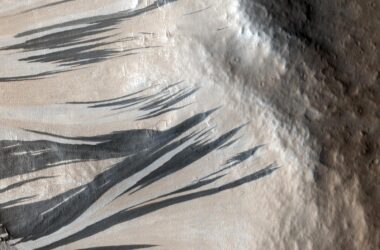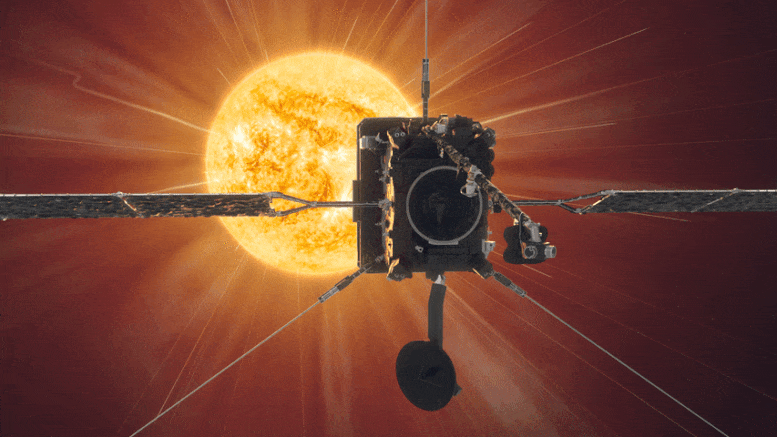
Animation de l’explorateur solaire Solar Orbiter de l’ESA. Crédit : ESA/Medialab
Les dernières images de Solar Orbiter montrent le Soleil entier dans des détails sans précédent. Elles ont été prises le 7 mars 2022, lorsque le vaisseau spatial passait directement entre la Terre et le Soleil.
L’une des images, prise par l’imageur d’ultraviolets extrêmes (EUI), est l’image à la plus haute résolution du disque complet du Soleil et de l’atmosphère extérieure, la couronne, jamais prise.
Une autre image, prise par l’instrument SPICE (Spectral Imaging of the Coronal Environment) représente la première image du Soleil complet de ce type depuis 50 ans, et de loin la meilleure, prise à la longueur d’onde Lyman-bêta de la lumière ultraviolette émise par l’hydrogène.
Les images ont été prises lorsque Solar Orbiter se trouvait à une distance d’environ 75 millions de kilomètres, soit à mi-chemin entre notre monde et son étoile mère. Le télescope haute résolution de l’EUI prend des photos d’une telle résolution spatiale qu’à cette distance rapprochée, une mosaïque de 25 images individuelles est nécessaire pour couvrir l’ensemble du Soleil. Prise l’une après l’autre, l’image complète a été capturée sur une période de plus de quatre heures car chaque tuile prend environ 10 minutes, y compris le temps pour le vaisseau spatial de pointer d’un segment à l’autre.
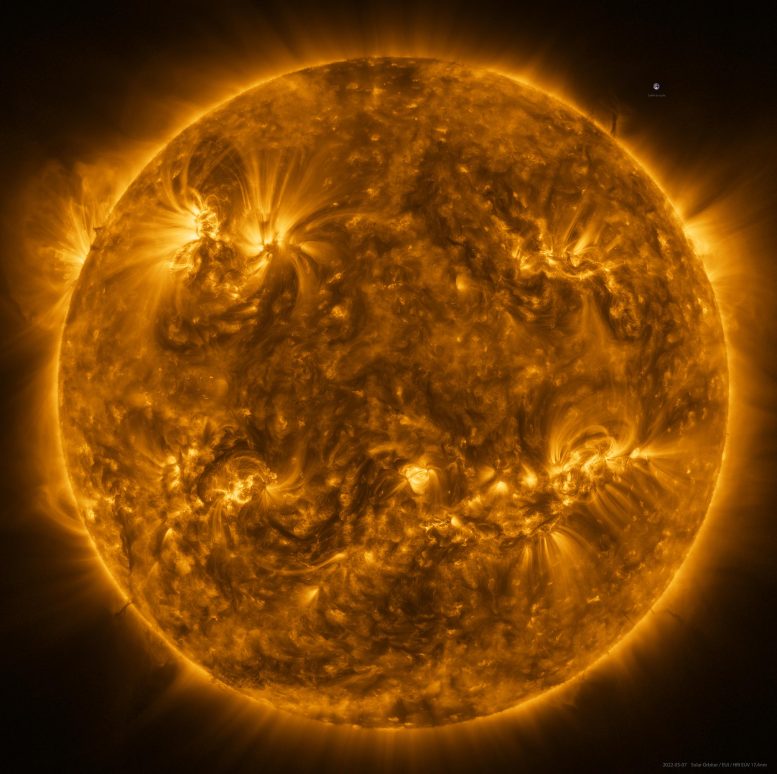
Le Soleil vu par Solar Orbiter dans la lumière ultraviolette extrême à une distance d’environ 75 millions de kilomètres. L’image est une mosaïque de 25 images individuelles prises le 7 mars 2022 par le télescope haute résolution de l’instrument EUI (Extreme Ultraviolet Imager). Prise à une longueur d’onde de 17 nanomètres, dans la région ultraviolette extrême du spectre électromagnétique, cette image révèle la haute atmosphère du Soleil, la couronne, dont la température avoisine le million de degrés Celsius. Une image de la Terre est également incluse à l’échelle, à la position 2 heures. Crédit : ESA & ; NASA/Solar Orbiter/EUI team ; Traitement des données : E. Kraaikamp (ROB)
Au total, les image finale contient plus de 83 millions de pixels dans une grille de 9148 x 9112 pixels. À titre de comparaison, cette image a une résolution dix fois supérieure à celle que peut afficher un écran de télévision 4K.
EUI image le Soleil à une longueur d’onde de 17 nanomètres, dans la région ultraviolette extrême du spectre électromagnétique. Cela révèle la haute atmosphère du Soleil, la couronne, qui a une température d’environ un million de degrés Celsius.

Solar Orbiter took images of the Sun on March 7, from a distance of roughly 75 million kilometres, using its Spectral Imaging of the Coronal Environment (SPICE) instrument. SPICE takes simultaneous “spectral images” at several different wavelengths of the extreme ultraviolet spectrum by scanning its spectrometer slit across a region on the Sun. The different wavelengths recorded correspond to different layers in the Sun’s lower atmosphere. Purple corresponds to hydrogen gas at a temperature of 10,000°C, blue to carbon at 32,000°C, green to oxygen at 320,000°C, yellow to neon at 630,000°C. Each full-Sun image is made up of a mosaic of 25 individual scans. It represents the best full Sun image taken at the Lyman beta wavelength of ultraviolet light that is emitted by hydrogen gas. Credit: ESA & NASA/Solar Orbiter/SPICE team; Data processing: G. Pelouze (IAS)
At the 2 o’clock (near the image of the Earth for scale) and 8 o’clock positions on the edges of the Sun, dark filaments can be seen projecting away from the surface. These ‘prominences’ are prone to erupt, throwing huge quantities of coronal gas into space and creating ‘space weather’ storms.
In addition to EUI, the SPICE instrument was also recording data during the crossing. These too needed to be pieced together as a mosaic.
SPICE is designed to trace the layers in the Sun’s atmosphere from the corona, down to a layer known as the chromosphere, getting closer to the surface. The instrument does this by looking at the different wavelengths of extreme ultraviolet light that come from different atoms.
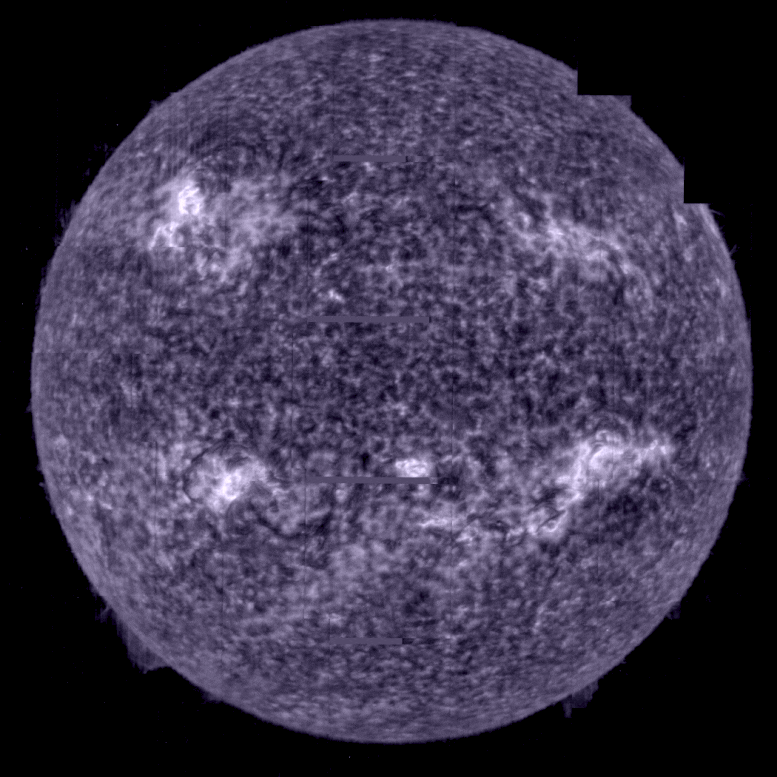
Taking the Sun’s temperature. Credit: ESA & NASA/Solar Orbiter/SPICE team; Data processing: G. Pelouze (IAS)
In the SPICE sequence of images purple corresponds to hydrogen gas at a temperature of 10,000°C, blue to carbon at 32,000°C, green to oxygen at 320,000°C, yellow to neon at 630,000°C.
This will allow solar physicists to trace the extraordinarily powerful eruptions that take place in the corona down through the lower atmospheric layers. It will also allow them to study one of the most puzzling observations about the Sun: how the temperature is rising through the ascending atmospheric layers.
Usually the temperature drops as you move away from a hot object. But above the Sun, the corona reaches a million degrees Celsius whereas the surface is only about 5000°C. Investigating this mystery is one of the key scientific objectives of Solar Orbiter.
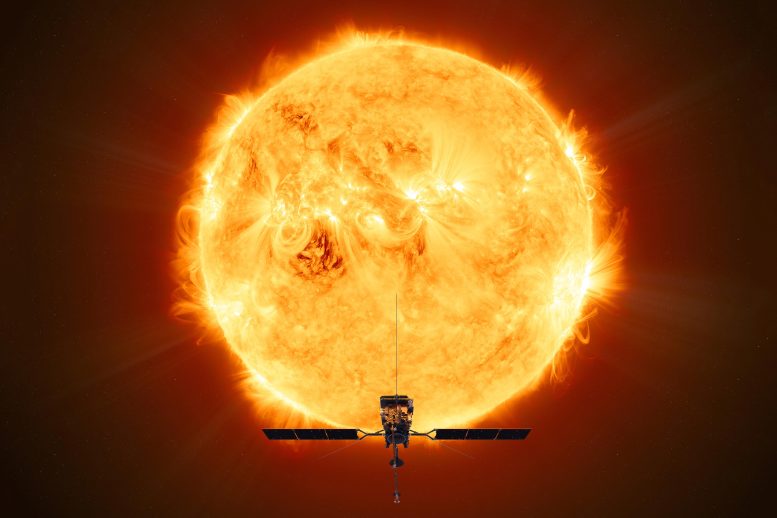
ESA’s Solar Orbiter. Credit: ESA/ATG medialab
The images were taken on 7 March, precisely when Solar Orbiter crossed the Sun-Earth line, so the images can be compared with Earth-bound solar instruments and cross-calibrated. This will make it easier to compare results from different instruments and observatories in future.
On March 26, Solar Orbiter reaches another mission milestone: its first close perihelion. The spacecraft is now inside the orbit of Mercury, the inner planet, taking the highest resolution images of the Sun it can take. It is also recording data on the solar wind of particles that flows outwards from the Sun.
And this is just the start, over the coming years the spacecraft will repeatedly fly this close to the Sun. It will also gradually raise its orientation to view the Sun’s previously unobserved polar regions.
Solar Orbiter is a space mission of international collaboration between ESA and NASA.

